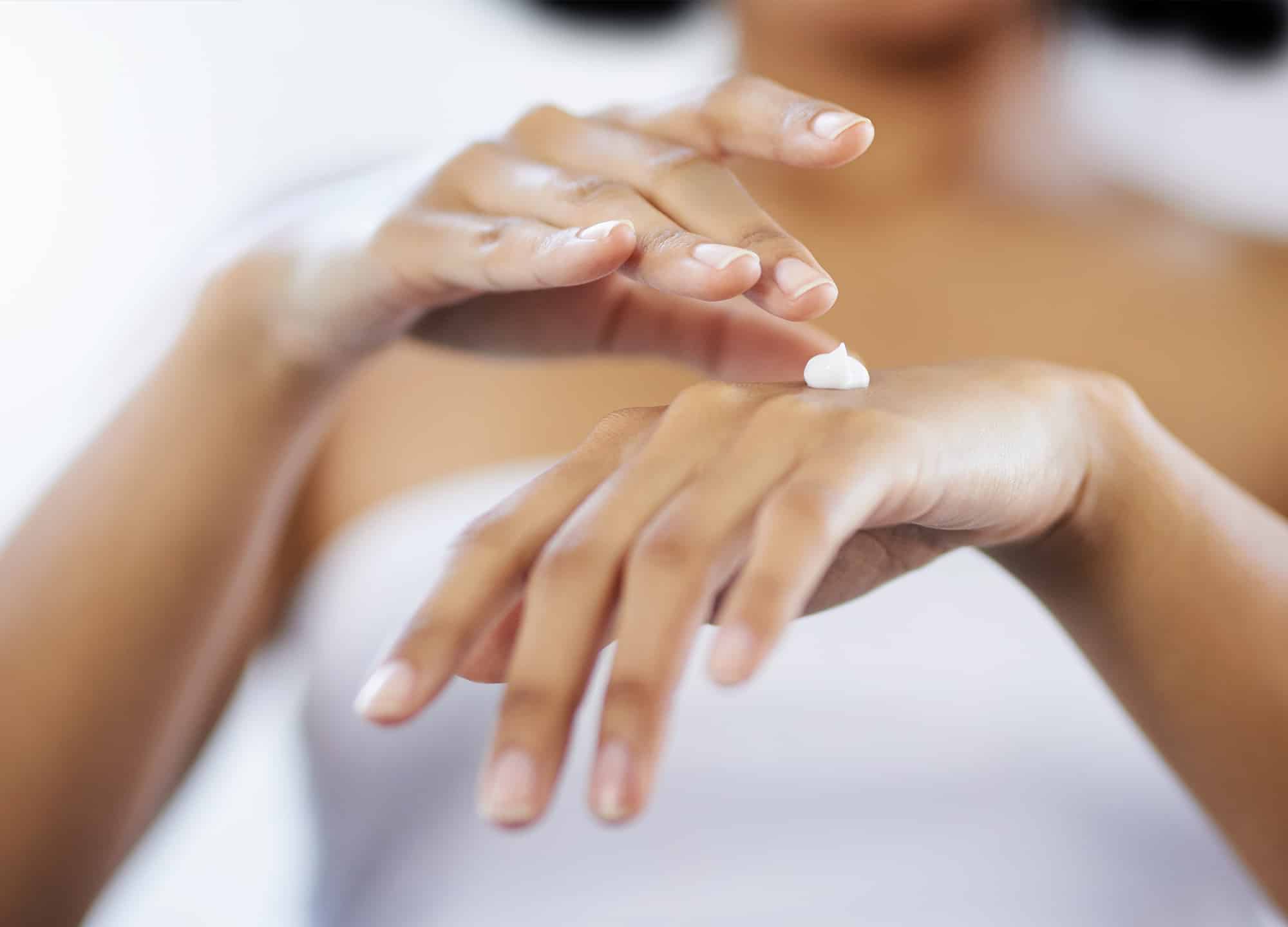There’s a scene in Gone with the Wind when Scarlett O’Hara, dressed in a gown made from her mother’s drapes, goes to Atlanta to convince Rhett Butler to give her $300 for the taxes on her family’s plantation. She tells him how well things have been going, and he believes her lie—that is, until he sees her hands. “What have you been doing with your hands?” he demands. “These don’t belong to a lady. You’ve been working with them like a field hand!” And just as they betrayed Miss O’Hara in 1939, hands remain a dead giveaway of one’s lifestyle and age today.
“Our hands can show our age more than anywhere else on the body,” says Dr. Tracy Evans, a board-certified dermatologist in San Francisco. Not only is the skin on our hands thinner to begin with, our hands are also constantly exposed to sunlight, which can lead to age spots, collagen destruction, further thinning of the skin, and general signs of premature aging, she explains. The fat that is found in the hands also naturally atrophies as we age, exposing the underlying veins and tissue, and leaving the hands looking boney, and, well, generally old.
Yet when it comes to skin care and cosmetic treatments, we don’t devote even half as much attention to our hands as we do our faces. “People, over the years, have had such an obsession with anti-aging strategies for their faces, but when you take a look at them and see everything, they really do have young faces and old hands,” says Dr. Gerald Imber, a board-certified plastic surgeon in New York City. “It’s only recently that patients have become interested in making everything congruent, so the requests we get for doing something about the hands, either preventatively or correctively, have skyrocketed over the last five or so years.” As hand rejuvenation has grown in demand, so too have the anti-aging hand treatments available. Here, doctors explain how to make hands look younger, including both in-office procedures and easy, at-home solutions.
In-office anti-aging hand treatments
Fat transfer
“As someone ages, they lose fat and bone density, and hands get a sort of witchy look,” explains Dr. Norman Rowe, a board-certified plastic surgeon in New York City. “We always think of fat as bad, but it actually gives a youthful look—so you want to keep a certain amount.” One solution for fat loss, and the hand rejuvenation treatment favored by many doctors, is a fat transfer. Usually done in tandem with another fat transfer or other procedure, fat is harvested from one area of the body—typically the belly or buttocks—spun and cleaned, and then gradually inserted into the deficient areas of the hands through tiny, near-microscopic incisions. This helps the hands appear more youthful, smoothing out the texture and hiding veins and tendons. “It may take a couple of treatments, because you can’t guarantee how much fat will take—sometimes 60% will take in one hand and 70% in the other,” Dr. Rowe says. “But the good thing about fat grafting is that it’s your own fat, so it won’t be rejected, and it’s a permanent solution.”
Renuva
This injectable filler is derived from human tissue, and is made up of the same proteins and collagen found in the body’s own fat. When injected into the skin, it creates a honeycomb-like matrix that’s filled in with your own fat; after three to six months, the injectable dissolves but the fat remains, explains Dr. Anna Guanche, a board-certified dermatologist in Calabasas, California. It can be used in the face and body, but is an especially good choice for hands: “It restores volume loss to help camouflage veins and tendons, giving the hands a naturally youthful appearance,” she explains. You’re getting similar benefits as fat transfer, but there’s no liposuction required, and the long-lasting results are another boon. “Patients appreciate that they don’t need to go on the same maintenance schedule as with other injectables that may require them to return every six months to a year. I do have them come back three to six months after the treatment to see if they’re happy with the results or want more volume, but this is a long-lasting treatment. It lasts as long as the natural fat cells last, which varies for every individual, but this could be up to 10 years,” she points out. The final cost depends on how much Renuva is needed and your particular provider, but Dr. Guanche cites $3,000 to $6,000 as an average.
Dermal fillers
Though hyaluronic acid filler has long been a go-to for restoring lost volume in the face, it wasn’t approved by the FDA for use in the hands until 2018. Since then, fillers have been an easy, fast, and reliable solution for aging hands. In the same way that fat transfer adds plumpness, filler can quite literally fill thinning areas to provide a smoother look. Hyaluronic acid fillers—Juvederm Voluma or Vollure or Restylane Lyft—can be used to help create volume and add softness to the hands, says Dr. Evans. Radiesse, made from calcium hydroxylapatite, a substance that’s naturally found in bones, is another option that’s FDA-approved for hand volumization is another option, she adds. It works by stimulating the production of collagen overtime, though also provides a bit of an instant plumping effect, thanks to the gel-like carrier substance.
Depending on both the patient and the doctor, the filler will be injected either in small amounts between the tendons or in one large dose, in the center of the hand, to then move around. While filler is typically a less invasive and less expensive option than fat grafting, it’s not as long lasting. “I usually inject hands every 12 to 18 months, though some patients may get up to two years, depending on which filler is used,” says Dr. Evans. “Filler can also look unnatural,” warns Dr. Imber. “It’s not real, alive, or permanent. I recommend fat over filler all the time, but that doesn’t mean filler isn’t right for certain people.”
IPL
Another undeniable sign of aging on the hands takes the form of dark spots and hyperpigmentation. Typically caused by sun exposure over time, these pervasive spots are, luckily, fairly easy to deal with by using an IPL laser. “The IPL will pick up the color of the dark spots, and it will initially make them darker—but over the next week, they’ll flake off,” Dr. Imber says. Most patients require several treatments, depending on how many brown spots there are and how deep they go, but IPL treatments can be done once a month until the results are satisfactory. (For context, Dr. Guanche says she typically performs a series of four, monthly treatments.) The laser will, however, make the skin very sun-sensitive, so it’s best to do IPL during the winter months. Another downside: it’s not recommended for dark skin tones.
CO2 lasers
Though less common than IPLs, CO2 or Fraxel laser treatments can be an extremely effective way to address both wrinkled texture and any sagging skin left in the hands after filler or fat transfer. “Much in the same way that you would with the face, you can laser with a Fraxel to tighten up extra skin,” says Dr. Rowe. Not only do you get the tightening effects, Fraxel is also an excellent way to address irregular color and texture, Dr. Evans adds. That being said, this likely won’t be a one-and-done situation. “I usually recommend three to five treatments, depending on the degree of sun damage and the patient’s age, performed every six to eight weeks,” she says. And, as is the case with IPL, avoiding the sun before and after treatment is imperative.
At-home anti-aging hand treatments
Sunscreen
Everyone knows that applying sunscreen is a crucial tool in the battle against aging, but many people often skip their hands, either forgetting that they too need protection or unintentionally washing it off soon after application. “The hands are often neglected, but if you want to keep them looking like they’re in the same decade as your face, you need to take care of them and use sun protection in the same manner,” says Dr. Guanche. Given that exposure to UV rays contributes to both collagen breakdown and hyperpigmentation on the hands (as well as increases the likelihood of skin cancer), applying SPF onto the backs of your hands every day is an absolute must; it really is the best kind of anti-aging hand cream you can get. Top tip: In order to remember to make it a part of your skin care routine, whenever you put sunblock on your face, put it on your hands at the same time, Dr. Imber advises. It needs to be reapplied too, particularly after hand-washing and/or if you’re going to be outside all day, Dr. Evans notes. We like Supergoop! Forever Young Hand Cream with SPF 40 ($14), a hydrating formula that has built-in sun protection. Another option: Wear gloves if you know you’re going to be spending a prolonged period of time outdoors, Dr. Evans suggests.
Vitamin C
Vitamin C is one of those wunderkind ingredients that we’re often told should be a mainstay in our bathroom cabinets, but few of us remember to use it beyond the face. “The use of vitamin C serum on the backs of hands is really terrific,” explains Dr. Imber. “It does wonders for sun damage, and a side benefit is that it helps protect against future sun damage.” Vitamin C also penetrates the skin almost immediately, so there’s little need to worry about washing it off throughout the day. More than with most skin-care ingredients though, one must be incredibly discerning when choosing a vitamin C product. “There are so many vitamin C serums out there, and so few of them are real,” says Dr. Imber, noting that patients should look for vitamin C l-ascorbic acid rather than vitamin C esters. “It also needs to be protected from the sun, protected from light, and protected from oxygen, so it should come in a dark bottle. It almost always has a short shelf life, but it works.” Skinceuticals C E Ferulic ($166) is pricey, but it checks all the boxes; derms and editors swear by it. Not to mention that it combines vitamin C with vitamin E and ferulic acid, two other very potent antioxidants.
Retinoids
Retinoids, whether prescription or over-the-counter, stimulate collagen production (and possibly elastin, too) to target wrinkling and speed up cell turnover to combat unwanted pigmentation and sun spots—and that applies for both the hands and the face. Dr. Evans often recommends a prescription-strength retinoid, such as tretinoin, though an OTC retinol will also help. Either way, she suggests mixing it with a moisturizer (think a basic hand cream or lotion) and applying it to your hands at night. (Not only is there no likelihood of you washing it off at night, but retinoids also do make the skin sun-sensitive. Plus, the moisturizer will help combat dry skin.) Keep in mind that if you’re really concerned about an aged appearance to your hands, topical products alone may not make enough of a difference, notes Dr. Imber. Still, these are good options to use in continuous with in-office options, as well as for the younger crowd who wants to prevent signs of aging in the first place.
Exfoliation
Last, and perhaps most theoretical, is exfoliation. “An interesting phenomenon is that most surgeons, of any age, don’t have brown spots on their hands because they’re scrubbing every day with a brush,” Dr. Imber says. “So it’s clear that exfoliation and getting those dead skin cells off really helps as well.” In addition to regular use of sunscreen, vitamin C, and retinol, he suggests scrubbing the backs of hands every day with a washcloth, brush, or gentle exfoliating product. “It doesn’t hurt anything, and it brings blood supply into the hands—so it’s a very simple, do-at-home preventative measure.”











